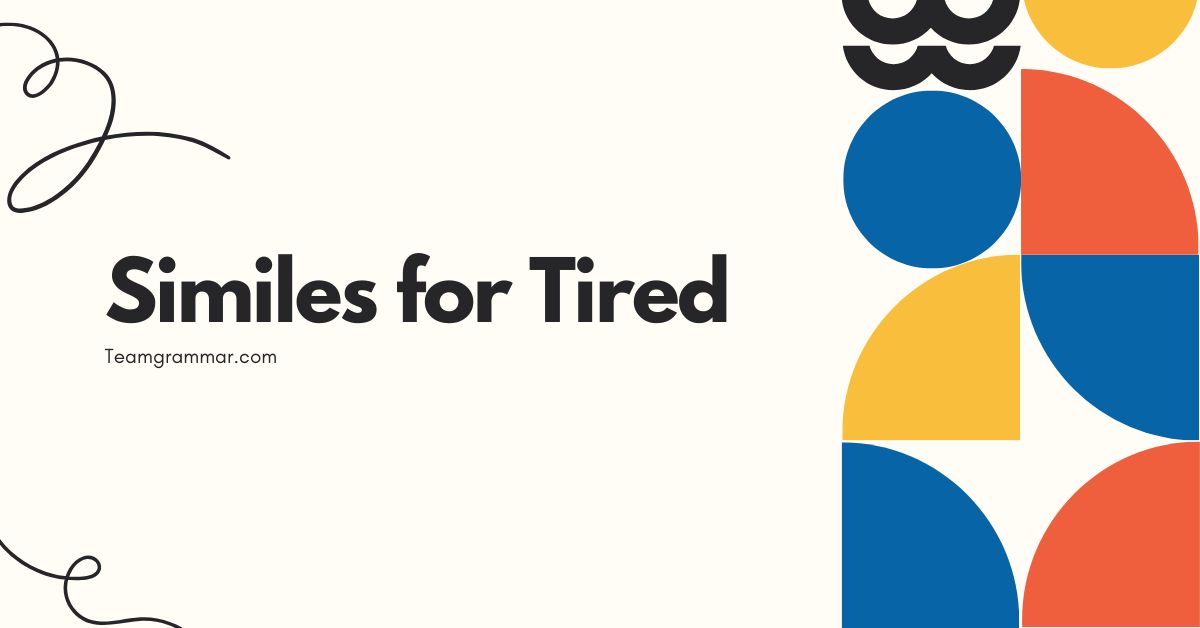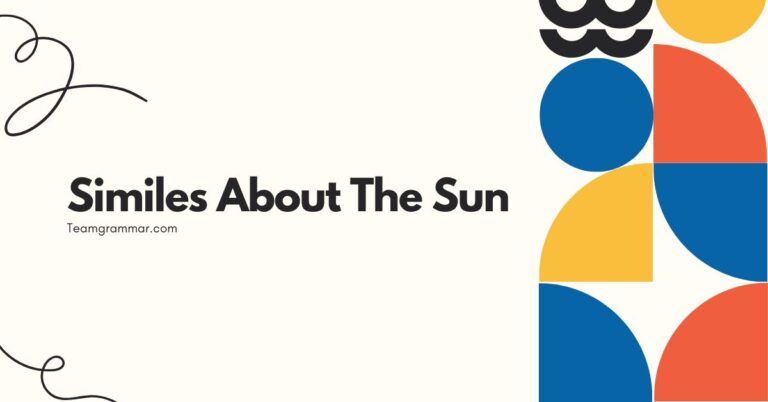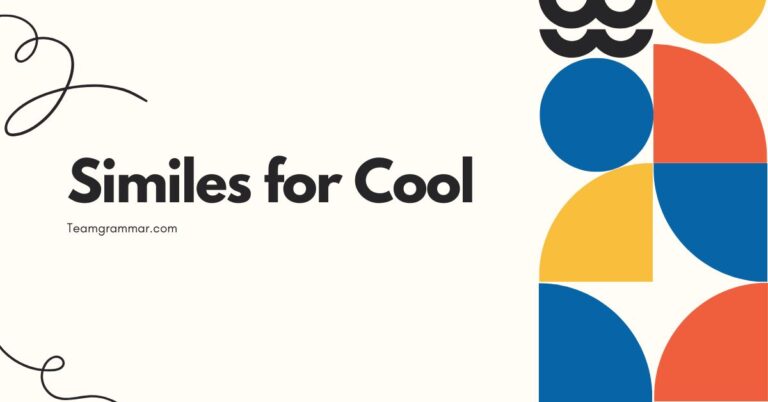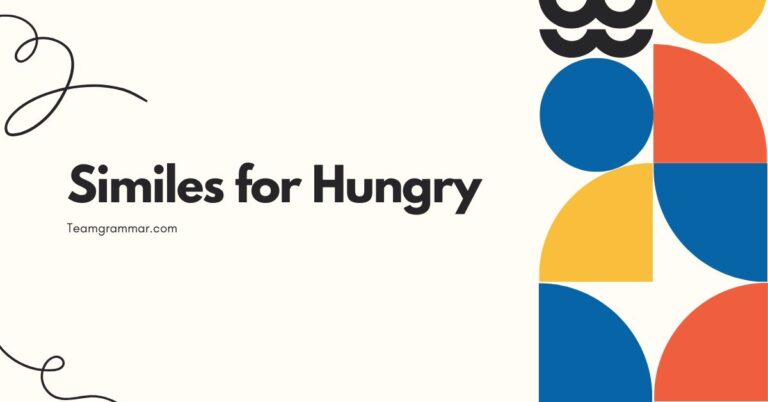47 Similes for Tired: A Comprehensive Guide with Examples
Understanding similes is crucial for enhancing descriptive writing and adding color to everyday language. Similes, comparisons using “like” or “as,” allow us to paint vivid pictures with words, making our communication more engaging and effective.
This article focuses specifically on similes used to describe tiredness, exploring various ways to express this common feeling. Whether you’re a student, writer, or simply someone looking to expand your vocabulary, this guide will provide you with the knowledge and examples you need to master similes for tiredness.
Table of Contents
- Introduction
- Definition of Simile
- Structural Breakdown of Similes
- Types of Tired Similes
- Examples of Similes for Tired
- Usage Rules for Similes
- Common Mistakes with Similes
- Practice Exercises
- Advanced Topics in Similes
- Frequently Asked Questions
- Conclusion
Definition of Simile
A simile is a figure of speech that compares two different things using the words “like” or “as.” The purpose of a simile is to create a vivid comparison that enhances the reader’s understanding or appreciation of the subject being described. Similes are a fundamental part of figurative language and are used extensively in literature, poetry, and everyday conversation.
Similes fall under the broader category offigures of speech, which are literary devices used to convey meaning indirectly. Unlike metaphors, which directly equate two things (e.g., “He is a lion”), similes make an explicit comparison, acknowledging the difference between the two items while highlighting their similarity.
This explicit comparison is what distinguishes similes from other figurative language techniques.
The function of a simile is to add depth and color to writing. By drawing a comparison to something familiar, similes help readers visualize and connect with the subject matter.
For example, saying “He was as tired as a dog after a long hunt” creates a much more powerful image than simply saying “He was tired.” The simile evokes a sense of extreme exhaustion and physical weariness.
Similes can be used in a variety of contexts, from describing physical states (like tiredness) to conveying abstract concepts. They are particularly useful in creative writing, where the goal is to create a strong impression on the reader.
However, similes can also be effective in persuasive writing, where they can be used to make an argument more relatable or convincing.
Structural Breakdown of Similes
The basic structure of a simile consists of three main components: thesubject, thelinking word(either “like” or “as”), and theobject of comparison. The subject is the thing being described, and the object of comparison is the thing it is being compared to.
The linking word establishes the relationship between the two.
The general formula for a simile is: Subject + Linking Word + Object of Comparison. For example, in the simile “She was as quiet as a mouse,” “she” is the subject, “as” is the linking word, and “a mouse” is the object of comparison.
The effectiveness of a simile depends on the strength of the connection between the subject and the object of comparison. A good simile will draw a clear and meaningful parallel between the two, highlighting a shared characteristic or quality.
The more unexpected or creative the comparison, the more memorable and impactful the simile will be.
The linking words “like” and “as” are generally interchangeable in similes, although there may be subtle differences in their usage. “As” is often used when the comparison is based on a specific quality or characteristic, while “like” is used for a more general comparison.
However, these are not strict rules, and the choice between “like” and “as” often comes down to personal preference or stylistic considerations.
Similes can be modified or expanded to add more detail and nuance. For example, adjectives and adverbs can be used to further describe the subject or the object of comparison.
Prepositional phrases can also be added to provide additional context or clarify the comparison. For example, “He felt as heavy as lead after the grueling workout” is a more detailed and descriptive simile than “He felt as heavy as lead.”
Types of Tired Similes
Similes for “tired” can be categorized based on the type of tiredness they describe. This includes physical exhaustion, mental fatigue, and emotional weariness.
Each category conveys a distinct feeling and can be expressed through specific comparisons.
Physical Exhaustion
Similes for physical exhaustion describe the feeling of being physically drained or depleted of energy. These similes often involve comparisons to heavy objects, worn-out animals, or objects that have been used extensively.
The goal is to convey the sense of physical heaviness, fatigue, and lack of strength.
Examples of similes for physical exhaustion include: “as tired as a dog after a long hunt,” “as heavy as lead,” “like a wrung-out cloth,” and “like a marathon runner at the finish line.” These similes evoke a sense of extreme physical weariness and the need for rest and recovery.
Mental Fatigue
Similes for mental fatigue describe the feeling of being mentally drained or unable to concentrate. These similes often involve comparisons to foggy weather, overloaded computers, or objects that have been stretched to their limits.
The goal is to convey the sense of mental cloudiness, confusion, and lack of focus.
Examples of similes for mental fatigue include: “as foggy as a morning in London,” “like a computer with too many programs running,” “like a stretched rubber band,” and “like a brain fried by too much studying.” These similes evoke a sense of mental exhaustion and the need for mental rest and relaxation.
Emotional Weariness
Similes for emotional weariness describe the feeling of being emotionally drained or depleted. These similes often involve comparisons to withered flowers, empty vessels, or objects that have been through a lot of hardship.
The goal is to convey the sense of emotional emptiness, sadness, and lack of motivation.
Examples of similes for emotional weariness include: “as withered as a forgotten flower,” “like an empty shell,” “like a ship lost at sea,” and “like a heart that has been broken too many times.” These similes evoke a sense of emotional exhaustion and the need for emotional healing and support.
Examples of Similes for Tired
Here are extensive examples of similes for “tired,” organized by category. Each category includes a variety of similes to illustrate the different ways of expressing tiredness.
Physical Exhaustion Examples
The following table provides examples of similes that describe physical exhaustion. Each simile aims to capture the feeling of being physically drained and depleted of energy.
| Simile | Explanation |
|---|---|
| As tired as a dog after a long hunt | Highlights the extreme physical exertion of a hunting dog. |
| As heavy as lead | Emphasizes the feeling of physical heaviness and fatigue. |
| Like a wrung-out cloth | Conveys the feeling of being completely drained of energy. |
| Like a marathon runner at the finish line | Illustrates the exhaustion after a long and strenuous race. |
| As weary as an old workhorse | Compares the subject to a horse that has worked hard for many years. |
| Like a deflated balloon | Suggests a loss of energy and vitality. |
| As limp as a wet noodle | Describes a lack of physical strength and energy. |
| Like a battery that’s completely drained | Illustrates the feeling of having no energy left. |
| As beat as a drum | Emphasizes the feeling of being worn out and exhausted. |
| As sluggish as a snail | Conveys a sense of slowness and lack of energy. |
| Like a car running on empty | Suggests that the subject is running out of energy. |
| As drained as a swimming pool after a party | Highlights the feeling of being completely emptied of energy. |
| Like a spent firework | Illustrates the feeling of having used up all available energy. |
| As worn out as an old pair of shoes | Compares the subject to something that has been used extensively. |
| Like a wilted flower | Suggests a loss of vitality and freshness. |
| As flattened as a pancake | Describes a feeling of being completely flattened and exhausted. |
| Like a zombie shuffling along | Illustrates a slow, lifeless movement due to exhaustion. |
| As exhausted as a miner after a long shift | Compares the subject to someone who has done hard physical labor. |
| Like a rag doll | Suggests a lack of energy and control over one’s body. |
| As tired as a truck driver on his last mile | Highlights the extreme fatigue of a long-distance driver. |
| Like an old engine sputtering and dying | Conveys the feeling of running out of steam. |
| As weary as a traveler who has walked for miles | Emphasizes the physical weariness of a long journey. |
| Like a tree after a storm | Suggests a feeling of being battered and exhausted. |
| As drained as a river in the dry season | Illustrates the feeling of being completely depleted. |
| Like a shadow stretching long and thin | Conveys a feeling of weakness and exhaustion. |
| As lifeless as a stone | Describes a complete lack of energy and vitality. |
| Like a ghost floating aimlessly | Suggests a lack of purpose and energy due to exhaustion. |
Mental Fatigue Examples
The table below provides examples of similes that describe mental fatigue. Each simile aims to capture the feeling of being mentally drained and unable to concentrate.
| Simile | Explanation |
|---|---|
| As foggy as a morning in London | Highlights the feeling of mental cloudiness and confusion. |
| Like a computer with too many programs running | Illustrates the feeling of being mentally overloaded. |
| Like a stretched rubber band | Suggests that the subject has been stretched to their mental limits. |
| Like a brain fried by too much studying | Conveys the feeling of mental exhaustion after intense studying. |
| As blank as a whiteboard | Describes a lack of ideas or mental clarity. |
| Like a broken record skipping | Suggests repetitive and unproductive thoughts. |
| As muddled as a jigsaw puzzle | Illustrates a feeling of confusion and disarray. |
| Like a radio with static | Conveys a lack of clear mental reception. |
| As slow as molasses | Emphasizes the feeling of mental slowness and difficulty concentrating. |
| Like a book with missing pages | Suggests a lack of complete understanding or knowledge. |
| As scattered as leaves in the wind | Illustrates a lack of focus and direction. |
| Like a tangled ball of yarn | Suggests a feeling of mental confusion and complexity. |
| As numb as a dentist’s patient | Describes a lack of mental feeling or awareness. |
| Like a sieve with holes | Suggests a difficulty in retaining information. |
| As dazed as a deer in headlights | Illustrates a feeling of confusion and disorientation. |
| Like a clock with a broken spring | Suggests a mental process that is not functioning properly. |
| As forgetful as an old man | Describes a difficulty in remembering things. |
| Like a maze with no exit | Suggests a feeling of being trapped and confused. |
| As senseless as a riddle with no answer | Illustrates a lack of understanding or meaning. |
| Like a light bulb flickering before it burns out | Conveys a sense of impending mental shutdown. |
| As fuzzy as an out-of-focus photograph | Highlights a lack of mental clarity. |
| Like a scratched CD skipping | Suggests a repetitive and disrupted mental process. |
| As dull as a butter knife | Describes a lack of mental sharpness and alertness. |
| Like a well that has run dry | Suggests a depletion of mental resources and ideas. |
| As unresponsive as a broken keyboard | Illustrates a difficulty in processing information. |
| Like a room filled with echoes | Conveys a feeling of mental emptiness and repetition. |
| As vacant as an empty stare | Describes a lack of mental engagement or focus. |
Emotional Weariness Examples
The following table provides examples of similes that describe emotional weariness. Each simile aims to capture the feeling of being emotionally drained and depleted.
| Simile | Explanation |
|---|---|
| As withered as a forgotten flower | Highlights the feeling of emotional decay and neglect. |
| Like an empty shell | Suggests a lack of emotional substance or vitality. |
| Like a ship lost at sea | Illustrates a feeling of emotional aimlessness and disorientation. |
| Like a heart that has been broken too many times | Conveys the feeling of emotional pain and vulnerability. |
| As hollow as a drum | Describes a lack of emotional depth or resonance. |
| Like a ghost haunting an empty house | Suggests a feeling of emotional isolation and loneliness. |
| As fragile as a glass ornament | Illustrates emotional vulnerability and sensitivity. |
| Like a puppet with its strings cut | Conveys a lack of emotional control or agency. |
| As numb as if frozen | Emphasizes the feeling of emotional detachment and apathy. |
| Like a barren landscape | Suggests a lack of emotional fertility and growth. |
| As drained as a tear duct | Illustrates a feeling of having cried all one’s tears. |
| Like a song with no melody | Suggests a lack of emotional harmony and beauty. |
| As silent as a tomb | Describes a lack of emotional expression or communication. |
| Like a bird with broken wings | Suggests a loss of emotional freedom and joy. |
| As empty as a promise unfulfilled | Illustrates a feeling of emotional disappointment and betrayal. |
| Like a story with no ending | Suggests a lack of emotional closure or resolution. |
| As colorless as a black and white photograph | Describes a lack of emotional vibrancy and color. |
| Like a candle that has burned out | Suggests a depletion of emotional energy and passion. |
| As desolate as a desert | Illustrates a feeling of emotional emptiness and isolation. |
| Like a clock that has stopped ticking | Conveys a sense of emotional stagnation and inertia. |
| As heavy as a heart filled with sorrow | Highlights the emotional burden of sadness and grief. |
| Like a painting with faded colors | Suggests a loss of emotional vibrancy and intensity. |
| As brittle as dry leaves in autumn | Describes emotional fragility and vulnerability. |
| Like a star that has lost its shine | Suggests a loss of emotional brilliance and inspiration. |
| As weary as a traveler who has lost their way | Illustrates a feeling of emotional confusion and disorientation. |
| Like a garden overgrown with weeds | Conveys a sense of emotional neglect and disorder. |
Usage Rules for Similes
Using similes effectively requires understanding some basic rules. The primary rule is that the two things being compared must be different enough to make the comparison interesting, but similar enough to make it meaningful.
A weak simile is one where the comparison is obvious or doesn’t add any real insight.
Another important rule is to avoid clichés. Overused similes like “as red as a rose” or “as quiet as a mouse” have lost their impact and can make your writing sound unoriginal.
Strive to create fresh and inventive comparisons that will surprise and delight your readers. For example, instead of “as quiet as a mouse,” you could say “as quiet as a shadow slipping across the floor.”
When using similes, be mindful of the context. The simile should be appropriate for the tone and style of your writing.
A humorous simile might be out of place in a serious or formal context, and vice versa. Consider your audience and the overall message you are trying to convey when choosing your similes.
It’s also important to ensure that your similes are grammatically correct. The linking words “like” and “as” should be used correctly, and the objects of comparison should be parallel in structure.
For example, it’s incorrect to say “He was as tired as sleeping.” Instead, you should say “He was as tired as someone who had been sleeping.”
Finally, don’t overuse similes. While they can be a powerful tool for descriptive writing, too many similes can make your writing sound cluttered and artificial.
Use them sparingly and strategically to create the greatest impact.
Common Mistakes with Similes
One common mistake is confusing similes with metaphors. A simile uses “like” or “as” to make a comparison, while a metaphor directly equates two things without using these words.
For example, “He is like a lion” is a simile, while “He is a lion” is a metaphor.
Another common mistake is using illogical or nonsensical comparisons. A good simile should draw a clear and meaningful parallel between the subject and the object of comparison.
If the comparison doesn’t make sense, it will only confuse the reader. For example, “He was as tired as a refrigerator” doesn’t make sense because there’s no clear connection between tiredness and refrigerators.
Overusing clichés is another frequent error. Clichéd similes lack originality and can make your writing sound uninspired.
Strive to create fresh and inventive comparisons that will engage your readers.
Misusing “like” and “as” can also lead to errors. Remember that “like” is a preposition, while “as” is a conjunction.
This means that “like” should be followed by a noun or pronoun, while “as” should be followed by a clause. For example, “He was tired like me” is incorrect; it should be “He was tired like I was.” Or, “He was as tired as I was” is correct.
Finally, forgetting the context of the writing is a common oversight. Always ensure that your similes are appropriate for the tone and style of your piece.
A humorous simile might be inappropriate in a serious context, and vice versa.
Here’s a table illustrating some common mistakes with similes:
| Incorrect | Correct | Explanation |
|---|---|---|
| He is a lion (when intending a simile) | He is like a lion. | This corrects a metaphor used as a simile. |
| He was as tired as a refrigerator. | He was as tired as someone who had run a marathon. | This replaces an illogical comparison with a meaningful one. |
| He was as quiet as a mouse (in a spy novel). | He was as quiet as a shadow slipping across the floor. | This replaces a cliché with a more original comparison. |
| He was tired like me. | He was tired like I was. | This corrects the misuse of “like” as a conjunction. |
| He was as tired as the sun (in a somber scene). | He was as tired as a soldier returning from war. | This replaces an inappropriate simile with a contextually relevant one. |
Practice Exercises
Test your understanding of similes with these practice exercises. Each exercise includes multiple questions with varying levels of difficulty.
Exercise 1: Identify the Simile
Identify the simile in each of the following sentences:
| Question | Answer |
|---|---|
| 1. The old house stood silent like a forgotten memory. | like a forgotten memory |
| 2. Her voice was music to his ears. | (None – this is a metaphor) |
| 3. He ran as fast as a cheetah. | as fast as a cheetah |
| 4. The world is a stage. | (None – this is a metaphor) |
| 5. She was as bright as the sun. | as bright as the sun |
| 6. The snow fell like feathers from the sky. | like feathers from the sky |
| 7. His words were a knife to her heart. | (None – this is a metaphor) |
| 8. The car was as old as the hills. | as old as the hills |
| 9. He eats like a pig. | like a pig |
| 10. She is the sunshine of my life. | (None – this is a metaphor) |
Exercise 2: Complete the Simile
Complete the following similes with an appropriate ending:
| Question | Answer |
|---|---|
| 1. As tired as… | as tired as a dog after a long hunt |
| 2. Like a … | like a deflated balloon |
| 3. As heavy as… | as heavy as lead |
| 4. Like a … | like a brain fried by too much studying |
| 5. As blank as… | as blank as a whiteboard |
| 6. Like an… | like an empty shell |
| 7. As hollow as… | as hollow as a drum |
| 8. Like a… | like a ship lost at sea |
| 9. As slow as… | as slow as molasses |
| 10. Like a… | like a book with missing pages |
Exercise 3: Create Your Own Similes
Create your own similes for the following words:
| Word | Your Simile |
|---|---|
| 1. Sad | As sad as a rainy day. |
| 2. Happy | Like a child on Christmas morning. |
| 3. Angry | As angry as a hornet’s nest that’s been kicked. |
| 4. Scared | Like a leaf trembling in the wind. |
| 5. Excited | Like a coiled spring ready to be released. |
| 6. Bored | As bored as watching paint dry. |
| 7. Confused | Like a maze with no exit. |
| 8. Peaceful | As peaceful as a still lake at dawn. |
| 9. Energetic | Like a bolt of lightning. |
| 10. Calm | As calm as a gentle breeze. |
Advanced Topics in Similes
For advanced learners, exploring the nuances of similes can lead to more sophisticated writing. One advanced topic is the use ofextended similes.
An extended simile is a simile that is developed over several sentences or paragraphs, allowing for a more detailed and elaborate comparison. This technique can be particularly effective in creating vivid imagery and adding depth to your writing.
Another advanced topic is the use ofimplied similes. An implied simile is a simile that doesn’t explicitly use the words “like” or “as,” but still makes a comparison.
This can be achieved through the use of evocative language and imagery. For example, instead of saying “He moved like a shadow,” you could simply say “He shadowed the room,” implying the same comparison without using the linking word.
Understanding the cultural context of similes is also important for advanced learners. Similes often draw on shared cultural knowledge and experiences, and what is an effective simile in one culture may not be in another.
Being aware of these cultural differences can help you create similes that are more meaningful and relevant to your audience.
Finally, experimenting with unconventional and unexpected comparisons can lead to more original and impactful similes. Don’t be afraid to break the rules and try new things.
The most memorable similes are often those that challenge our expectations and make us see the world in a new way.
Frequently Asked Questions
Here are some frequently asked questions about similes:
- What is the difference between a simile and a metaphor?
A simile compares two things using “like” or “as,” while a metaphor directly equates two things without using these words. For example, “He is like a lion” is a simile, while “He is a lion” is a metaphor. The simile acknowledges the difference between the two items, while the metaphor suggests a complete identification.
- Can a simile be a cliché?
Yes, a simile can be a cliché if it is overused and lacks originality. Clichéd similes have lost their impact and can make your writing sound uninspired. It’s important to strive for fresh and inventive comparisons.
- How do I create a good simile?
To create a good simile, choose two things that are different enough to make the comparison interesting, but similar enough to make it meaningful. Avoid clichés and strive for originality. Be mindful of the context and ensure that the simile is appropriate for the tone and style of your writing.
- What are the linking words used in similes?
The linking words used in similes are “like” and “as.” These words establish the relationship between the subject and the object of comparison.
- Is it okay to use similes in formal writing?
Yes, similes can be used in formal writing, but they should be used sparingly and strategically. Choose similes that are appropriate for the tone and style of your writing, and avoid those that are too informal or humorous.
- How can I improve my use of similes?
To improve your use of similes, read widely and pay attention to how other writers use them. Experiment with different comparisons and try to create similes that are fresh and original. Practice writing similes regularly and get feedback from others.
- What is an extended simile?
An extended simile is a simile that is developed over several sentences or paragraphs, allowing for a more detailed and elaborate comparison. This technique can be particularly effective in creating vivid imagery and adding depth to your writing.
- What is an implied simile?
An implied simile is a simile that doesn’t explicitly use the words “like” or “as,” but still makes a comparison through the use of evocative language and imagery.
- Are similes only used in writing?
No, similes are used in both writing and speech. They are a common feature of everyday conversation as well as literary works.
- How do I avoid using clichés in my similes?
To avoid using clichés, brainstorm different comparisons and try to think outside the box. Look for unique and unexpected connections between the subject and the object of comparison. Ask yourself if the simile has been used countless times before; if so, try to come up with something more original.
Conclusion
Mastering similes is a valuable skill for anyone looking to enhance their writing and communication. By understanding the structure, types, and usage rules of similes, you can create vivid and memorable comparisons that will engage your readers and add depth to your message.
Remember to avoid clichés, be mindful of the context, and strive for originality. With practice and experimentation, you can become proficient in the art of creating effective similes.
This guide has provided you with a comprehensive overview of similes for “tired,” including numerous examples, practice exercises, and advanced topics. Use this knowledge to expand your vocabulary, improve your writing skills, and express yourself more effectively.
Don’t be afraid to experiment with different comparisons and find your own unique voice. The more you practice, the more confident and creative you will become in your use of similes.







